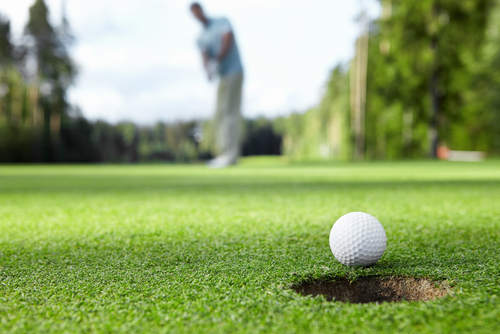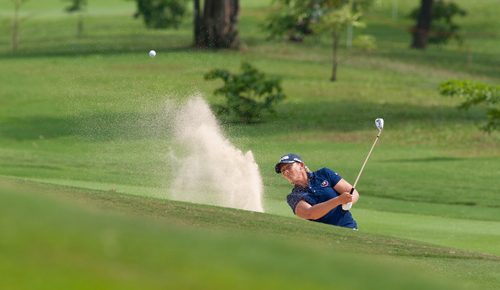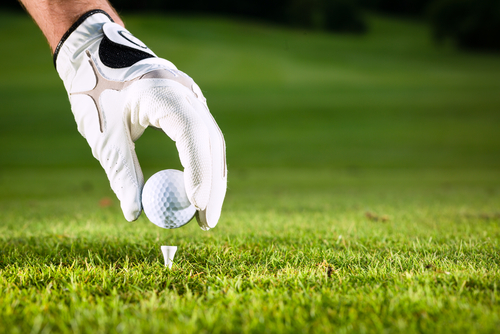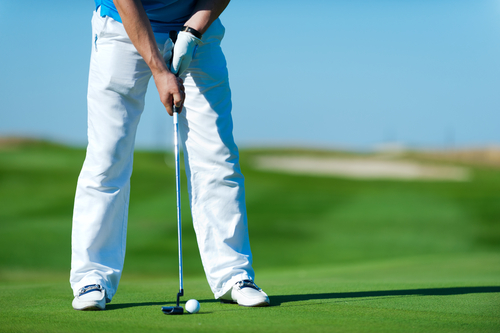Why Do Golf Balls Have Dimples: History of Golf Ball Construction
Jul 24th 2017
The game of golf goes back centuries, but it has evolved from a wooden stick and a bunch of feathers to the sophisticated clubs and balls we know now.
●In 80 B.C. the Roman emperors played “paganica.” They used a bent stick and a ball made from feathers, up to 7-inches in diameter. Later, people played with wooden balls.
●In 1360 golf was banned by Brussels!
●Scotland is usually credited as the home of modern golf, illustrated in the 18th-century painting by Jeremiah Davison of the MacDonald boys.

The Featherie
In the 17th century, they found a new way to make golf balls that would travel farther. They made these by boiling goose feathers and stuffing them into a cowhide pouch while still hot. They sewed up the pouch and, as it cooled, the feather expanded and the leather pouch shrunk. This idea resulted in a very tight ball of feathers. Finally, it was hammered into a roughly spherical shape and oiled.

They called this a “featherie.” It was the standard ball for over two centuries. They came in different sizes which were graded according to their weight and, later, their diameter.
Still seeking the perfect ball, people tried various woods, ivory, linen, and even metal balls, but the featherie remained the ball of choice.
The Gutta-Percha Ball
The featheries were expensive, as they were handmade, and so people sought a cheaper alternative—and came up with the gutta-percha ball. It takes its name from the resin gum of the sapodilla tree, from Southeast Asia. This gum could be heated up and placed into a round mold, and it would then dry hard. Despite being smooth and rounder than the featherie, they simply didn’t fly through the air as well. However, they were cheaper, which enabled the working classes to play. They remained popular until 1910.
Golfers were surprised to find the more they knocked the ball about, the further it traveled, so they made modifications to the gutta-percha balls—various patterns and cuts, with knives and a chisel-faced hammer—to try to improve the ball’s aerodynamics. They also tried adding such things as leather, rubber, and cork dust to the gutta-percha, and, although some additions made the balls tougher, they still didn’t go the distance.

During the 1870s, manufacturers used iron molds with regular patterns inscribed on the insides. These examples are taken from taken from Spalding’s Official Golf Guide 1800. The pattern projects from the surface rather than being pitted.
The Wound Core Ball
In 1898, the wound core ball was invented in Ohio. Apparently, Coburn Haskell was impatiently waiting for his golfing partner, Bertram Work, to finish work. As he waited, he played with a rubber thread, winding it into a ball. It bounced astonishingly well, so they covered the wound rubber thread and used it to play golf.
These wound balls are still around today.
About this time, someone found that indentations rather than protrusions improved the flight of the ball. Serious players found they could control the ball better and even put a backspin on it.
How Do Dimples Work?
The dimples decrease the drag and increase the lift of a golf ball. This lift enables the dimpled ball to fly almost three times further.

The dimples create turbulence in the air immediately around the ball. This turbulence causes an increase in air pressure behind the ball pushing it forward. As the ball flies, it leaves a wake of lower pressure behind it, a bit like the wake of a ship. A smooth ball leaves a larger wake, effectively dragging the ball backward; the dimples make the wake much smaller, thus reducing the drag.
When there is backspin on the ball, the lift also increases, as the air on the top of the ball moves faster, thus creating a lower air pressure above the ball, which causes lift. You can see the same effect with sideways spin—the ball veering to the side.
How Many Dimples?
Between 300 and 500 dimples is usual, with 392 the average. Increasing the number does not increase the distance the ball can travel.
What Shape Is a Dimple?
Dimples come in all shapes and depths. They can be large or small or different sizes on the same ball. Shapes include circles, ovals, teardrops, and hexagons.
Today’s Ball
Today, around 850 million golf balls are manufactured every year.
There are many designs, just as there are many different golf carts, but there are two main kinds of golf ball—the recreational ball and the advanced ball. The advanced ball needs to be hit with more power and creates more spin.
The main difference in design is that recreational balls have two layers to the cover, which is much firmer than the core, while the advanced balls have three or more layers and a soft cover compared to the firmer cores inside.
Complex computation is revealing new secrets about the flight of the golf ball, and, although the perfect pattern has yet to be elucidated, it is possible to design golf balls for specific owners. Many golfers prefer a particular type of golf ball and take pride in their equipment.
Conclusion
With advanced testing techniques, increasing computation powers, and the diligent searching for the perfect ball, there will almost certainly be more innovative approaches to the construction of the golf ball in the future.
